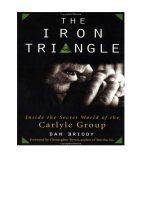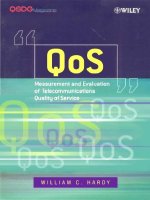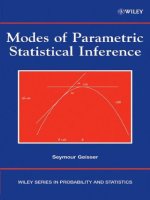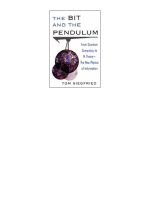John wiley sons corba fundamentals of distributed object systems the corba perspective2001
Bạn đang xem bản rút gọn của tài liệu. Xem và tải ngay bản đầy đủ của tài liệu tại đây (2.44 MB, 408 trang )
Fundamentals of Distributed Object Systems: The CORBA Perspective
Zahir Tari, Omran Bukhres
Copyright c 2001 John Wiley & Sons, Inc.
Print ISBN 0-471-35198-9 Electronic ISBN 0-471-20064-6
FUNDAMENTALS OF
DISTRIBUTED OBJECT
SYSTEMS
WILEY SERIES ON PARALLEL AND DISTRIBUTED
COMPUTING
Series Editor: Albert Y. Zomaya
Parallel and Distributed
Simulation
Systems / Richard Fujimoto
Surviving the Design of Microprocessor
Lessons Learned / Veljko Milutinovic
Mobile Processing
Introduction
in Distributed
and Multimicroprocessor
and Open Environments
to Parallel Algorithms
Systems:
/ Peter Sapaty
/ C. Xavier and S. S. lyengar
Solutions to Parallel and Distributed Computing Problems: Lessons from
Biological Sciences / Albert Y. Zomaya, Fikret Ercal, and Stephan Olariu (Editors)
New Parallel Algorithms for Direct Solution of Linear Equations
Murthy, K. N. Balasubramanya Murthy, and Srinivas Aluru
Practical PRAM Programming
Jesper Larsson Traeff
Computational
Collective
/ C. Siva Ram
/ Joerg Keller, Christoph Kessler, and
Intelligence
Parallel and Distributed Computing:
Approaches / Claudia Leopold
/ Tadeusz M. Szuba
A Survey of Models, Paradigms,
Fundamentals
of Distributed Object Systems:
Zahir Tari and Omran Bukhres
A CORBA Perspective
Pipelined Processor Farms: Structured Design for Embedded
Systems / Martin Fleury and Andrew Downton
Parallel
and
/
FUNDAMENTALS OF
DISTRIBUTED OBJECT
SYSTEMS
The CORBA Perspective
Zahir Tari
Omran Bukhres
A Wiley-Interscience Publication
JOHN WILEY & SONS, INC.
New York
•
Chichester
•
Weinheim
•
Brisbane
•
Singapore
•
Toronto
Designations used by companies to distinguish their products are often claimed as trademarks. In
all instances where John Wiley & Sons, Inc., is aware of a claim, the product names appear in
initial capital or ALL CAPITAL LETTERS. Readers, however, should contact the appropriate
companies for more complete information regarding trademarks and registration.
Copyright 2001 by John Wiley & Sons, Inc. All rights reserved.
No part of this publication may be reproduced, stored in a retrieval system or transmitted in any
form or by any means, electronic or mechanical, including uploading, downloading, printing,
decompiling, recording or otherwise, except as permitted under Sections 107 or 108 of the 1976
United States Copyright Act, without the prior written permission of the Publisher. Requests to the
Publisher for permission should be addressed to the Permissions Department, John Wiley & Sons,
Inc., 605 Third Avenue, New York, NY 10158-0012, (212) 850-6011, fax (212) 850-6008,
E-Mail:
This publication is designed to provide accurate and authoritative information in regard to the
subject matter covered. It is sold with the understanding that the publisher is not engaged in
rendering professional services. If professional advice or other expert assistance is required, the
services of a competent professional person should be sought.
ISBN 0-471-20064-6.
This title is also available in print as ISBN 0-471-35198-9.
For more information about Wiley products, visit our web site at www.Wiley.com.
Library of Congress Cataloging-in-Publication Data is available:
ISBN 0-471-35198-9 (cloth : alk. paper)
Printed in the United States of America.
10 9 8 7 6 5 4 3 2 1
In the memory of my father Si’Hmanou Tari
To my mother Takh’lit Madaoui
In the memory of my role model, my father,
Abdussalam Ali Bukhres
Contents
FOREWORD
xv
PREFACE
xix
ACKNOWLEDGMENTS
xxv
ACRONYMS
PART I
BASICS OF CORBA
1. Introduction to Distributed Systems
xxvii
1
3
1.1 Basics of Distributed Systems
1.1.1 Architectures
1.1.2 Characteristics
1.1.3 Advantages and Disadvantages
3
4
8
11
1.2 Distributed System Technologies
1.2.1 Socket
1.2.2 Remote Procedure Call
1.2.3 Remote Method Invocation
1.2.4 Distributed Computing Environment
1.2.5 Distributed Component Object Model
12
13
17
21
23
25
1.3 Summary
30
1.4 Review Questions
31
1.5 Exercises
31
2. Introduction to CORBA
32
2.1 Overall Picture
32
2.2 CORBA 1, CORBA 2, and CORBA 3
35
vii
viii
CONTENTS
2.3 Object Management Group
2.3.1 Reference Object Model
2.3.2 Object Management Architecture
36
36
43
2.4 Common Object Request Broker Architecture
2.4.1 ORB Core
2.4.2 Interface Definition Language
2.4.3 Interface and Implementation Repositories
2.4.4 Object Adaptors
2.4.5 CORBA Interoperability
46
48
49
52
54
56
2.5 CORBA Binding
2.5.1 Binding of Transient IORs
2.5.2 Binding Persistent IORs
57
57
58
2.6 CORBA and Existing Technologies
2.6.1 DCE vs. CORBA
2.6.2 DCOM vs. CORBA
2.6.3 RMI vs. CORBA
60
60
61
62
2.7 Summary
62
2.8 Review Questions
63
2.9 Exercises
63
3. CORBA Programming
64
3.1 Overall Picture
64
3.2 Basic CORBA Programming
3.2.1 Interface Definition Language
3.2.2 Static Invocation Interface
3.2.3 Static Skeleton Interface
67
67
85
90
3.3 Dynamic Types
3.3.1 TypeCode
3.3.2 Type Any
102
102
103
3.4 Advanced CORBA Programming
3.4.1 Dynamic Invocation Interface
3.4.2 Dynamic Skeleton Interface
3.4.3 Interface and Implementation Repositories
106
106
112
118
3.5 Summary
124
3.6 Review Questions
125
CONTENTS
3.7 Exercises
PART II
ADVANCED CORBA
4. Object Adaptors
ix
125
127
129
4.1 Overall Picture
129
4.2 Architectures
4.2.1 Basic Object Adaptor
4.2.2 Portable Object Adaptor
131
132
133
4.3 Technical Issues
4.3.1 Overview
4.3.2 Basic Object Adaptor
4.3.3 Portable Object Adaptor
138
138
141
145
4.4 Database Adaptors
151
4.5 Summary
160
4.6 Review Questions
161
4.7 Exercises
161
5. CORBA Interoperability
162
5.1 Overall Picture
162
5.2 Domain
163
5.3 Bridge
164
5.4 Interoperability Protocols
5.4.1 Internet Inter-ORB Protocol
5.4.2 Environment Specific Inter-ORB Protocol
166
177
178
5.5 Interoperable Object Reference
179
5.6 Summary
181
5.7 Review Questions
181
5.8 Exercises
182
6. CORBA Caching
183
6.1 Overall Picture
183
6.2 Caching Issues and Techniques
185
6.3 Cache Replacement
187
x
CONTENTS
6.3.1 Caching Consistency Algorithms
6.3.2 Other Issues
189
191
6.4 The Caching Approach
192
6.5 Architecture
193
6.6 Caching Model
196
6.7 Design
199
6.8 Testing
205
6.9 Summary
209
6.10 Review Questions
210
6.11 Exercises
210
PART III
CORBA SERVICES
7. Naming Service
211
213
7.1 Background
7.1.1 Naming
7.1.2 Case Studies
213
214
217
7.2 Functions
7.2.1 Name Resolution
7.2.2 Binding and Unbinding Names
7.2.3 Creating and Deleting Naming Contexts
7.2.4 Listing the Context of a Naming Context
220
224
225
227
230
7.3 Summary
230
7.4 Review Questions
231
7.5 Exercises
231
8. Trading Object Service
232
8.1 Overall Picture
8.1.1 Basic Concepts
8.1.2 OMG vs. ODP
232
232
235
8.2 An Illustrative Example with JTrader
8.2.1 Definition of a Service Offer
8.2.2 Service Export
8.2.3 Service Import
8.2.4 Result Manipulation
236
236
238
242
244
CONTENTS
xi
8.3 Architecture
8.3.1 Trader Components
8.3.2 Service Type Repository
8.3.3 Dynamic Property Evaluation
246
249
259
262
8.4 Constraints, Policies, and Preferences
263
8.5 Query Propagation
8.5.1 CORBA Query Routing
8.5.2 Semantic-based Query Routing
266
266
268
8.6 TOS Implementations
8.6.1 JTrader
8.6.2 TAO Trader
8.6.3 DOK Trader
270
270
271
272
8.7 Summary
274
8.8 Review Questions
275
8.9 Exercises
275
9. Event Service
277
9.1 Overall Picture
277
9.2 Push and Pull Models
9.2.1 DCE Event Management Service (XEMS) [81]
280
282
9.3 Architecture
9.3.1 Canonical Pull Model
284
286
9.4 Untyped Event Channel
9.4.1 Design Aspects
9.4.2 Implementation Aspects
287
287
290
9.5 Typed Event Channel
9.5.1 Design Aspects
9.5.2 Implementation Aspects
298
298
302
9.6 CORBA Event Service Implementations
9.6.1 OrbixTalk
9.6.2 TAOs Event Service
9.6.3 Electra
9.6.4 CyberBus
9.6.5 Orbix+ISIS
307
307
308
309
310
311
9.7 Discussion on QoS Issues
312
xii
CONTENTS
9.8 Summary
314
9.9 Review Questions
314
9.10 Exercises
10. Object Transaction Service
315
316
10.1 Overview
316
10.2 Basics of Transactions
10.2.1 Concepts
10.2.2 Concurrency Control Protocols
10.2.3 Commit Protocols
317
317
320
323
10.3 OTS Concepts
10.3.1 Interface Hierarchy
10.3.2 Context Propagation
10.3.3 Transactional Objects
10.3.4 Recoverable Objects
10.3.5 Transactional and Recoverable Servers
326
326
328
329
330
332
10.4 Transaction Scenario
333
10.5 OTS Implementations
10.5.1 Iona Transaction Service
10.5.2 Microsoft Transaction Service
336
336
338
10.6 Summary
340
10.7 Review Questions
340
10.8 Exercises
341
11. Object Query Service
342
11.1 Overall Picture
342
11.2 Background on Query Processing
11.2.1 Overview
11.2.2 Execution Strategies
11.2.3 Query Architecture
11.2.4 Join Operators
345
345
347
351
352
11.3 OQS Languages
11.3.1 Object Query Language
11.3.2 OQL Algebra
354
354
356
CONTENTS
xiii
11.4 OQS Components
11.4.1 QueryEvaluator
11.4.2 Collections and Iterator
11.4.3 QueryableCollection
11.4.4 QueryManager and Query Object
358
360
361
363
363
11.5 DOK Query Service
11.5.1 Query Execution Engine
11.5.2 Query Optimization
365
365
366
11.6 Summary
367
11.7 Review Questions
368
11.8 Exercises
369
REFERENCES
371
INDEX
377
Foreword
Innovations have been occurring at a predictable rate in certain technology domains
for many years. For example, Moore’s Law—where the capacity of general-purpose
computer chips has doubled every 18 months—is still going strong after three
decades. More recently, the speed of IP networks has been improving at an even
faster rate—known as Metcalf’s Law—where bandwidth increases by a factor of ten
every two years. At this point there is even a “bandwidth index,” similar to indices
that track the price/performance of other commodities, such as petroleum or electricity. The steady advance in these technologies is remarkable and is due in no small
part to decades of synergistic research, development, and education by academic,
industrial, and government partners around the world.
There are, however, important domains—particularly software-intensive distributed systems in telecommunications, health care, aerospace, and online financial
services—that are not improving at the same rate as Moore’s Law or Metcalf’s Law,
due to a variety of inherent and accidental complexities, such as partial failures,
distributed deadlock, and non-portable programming APIs. Consequently, although
computer and network hardware keeps getting smaller, faster, cheaper, and better at
a predictable pace, complex distributed software systems seem to get bigger, slower,
more expensive, and buggier, and the innovation cycles are hard to predict.
An appropriate metaphor for the challenges of software-intensive distributed systems appears in the movie Apollo 13, starring Tom Hanks. After an explosion in the
command module forces the crew into the lunar module, the carbon dioxide levels
grow dangerously high due to a broken air scrubber. At this crucial moment, a manager at Johnson space center walks into a room full of engineers and scientists sitting
around a table and dumps out a bag containing common components—such as toothpaste, Tang, and duct tape—found on the lunar module. He tells the group they’ve
got eight hours to take these components and assemble an air scrubber that will fit
into the appropriate opening, and if it is not right the first time, everyone is going to
die!
Increasingly, developers of complex software-intensive distributed systems—
especially large-scale mission-critical “systems of systems”—are facing challenges
analogous to those of the Apollo 13 engineers and scientists. In particular, timeto-market pressures and competition for consumers and personnel have created a
situation where distributed systems must be developed using a large number of
commodity-off-the-shelf (COTS) components, which are not developed in-house
xv
xvi
FOREWORD
and whose quality can thus rarely be controlled directly. Yet, just like the Apollo
13 engineers and scientists, we must quickly and robustly master the principles,
patterns, and protocols necessary to thrive in a COTS-centric environment because
our livelihood—and sometimes even our lives—depend upon our success.
Over the past decade, various techniques and tools have been developed to alleviate many accidental and inherent complexities associated with distributed software
systems. Some of the most successful of these techniques and tools center on distributed object computing (DOC) middleware, which resides between applications
and the underlying operating systems, protocol stacks, and hardware devices to simplify and coordinate how these components are connected and how they interoperate.
Just as communication protocol stacks can be decomposed into multiple layers, so
too can DOC middleware be decomposed into the following layers:
•
•
•
Infrastructure middleware, which encapsulates and enhances native OS communication and concurrency mechanisms to create object-oriented (OO) network programming components, such as reactors, acceptor-connectors, monitor
objects, active objects, and component configurators. These components help
eliminate many tedious, error-prone, and non-portable aspects of developing
and maintaining networked applications via low-level OS programming API,
such as Sockets or POSIX pthreads. Widely-used examples of infrastructure
middleware include Java virtual machines (JVMs) and the ADAPTIVE Communication Environment (ACE).
Distribution middleware, which use and extend the infrastructure middleware to
define a higher-level distributed programming model. This programming model
defines reusable APIs and components that automate common end-system network programming tasks, such as connection management, (de)marshaling,
demultiplexing, end-point and request demultiplexing, and multithreading.
Distribution middleware enables distributed applications to be programmed
using techniques familiar to developers of standalone applications, i.e., by
having clients invoke operations on target objects without concern for their
location, programming language, OS platform, communication protocols and
interconnects, and hardware. At the heart of distribution middleware are Object Request Brokers (ORBs), such as Microsoft’s Component Object Model
(COM)+, Sun’s Java remote Method Invocation (RMI), and the OMG’s Common Object Request Broker Architecture (CORBA), which is a key focus of
this book.
Common middleware services, which augment distribution middleware by
defining higher-level domain-independent services, such as event notifications,
logging, multimedia streaming, persistence, security, global time, real-time
scheduling and end-to-end quality of service (QoS), fault tolerance, concurrency control, and transactions. Whereas distribution middleware focuses
largely on managing end-system resources in support of an OO distributed
programming model, common middleware services focus on managing resources throughout a distributed system. Developers can reuse these services
to allocate, schedule, and coordinate global resources and perform common
FOREWORD
•
xvii
distribution tasks that would otherwise be implemented in an ad hoc manner
within each application.
Domain-specific services, which are tailored to the requirements of particular
domains, such as telecommunications, e-commerce, health care, process automation, or aerospace. Unlike the other three OO middleware layers—which
provide broadly reusable “horizontal” mechanisms and services—domainspecific services are targeted at vertical markets. Domain-specific services
are the least mature of the middleware layers today, due partly to the historical lack of distribution middleware and common middleware service standards, which provide a stable base upon which to create domain-specific
services. Since these services embody knowledge of application domains,
however, they can significantly increase system quality and decrease the cycletime and effort required to develop particular types of distributed applications.
As these DOC middleware layers mature they are becoming COTS products that
are readily available for purchase or open-source acquisition. COTS DOC middleware has become essential in software development organizations that face stringent time and resource constraints since it helps amortize software life-cycle costs
by leveraging previous development expertise and concentrating research efforts
that improve quality and performance. Ultimately, this R&D process will result in
software-intensive distributed systems that get smaller, faster, cheaper, and better at
a predictable pace, just as computer and network hardware do today.
The following factors have helped improve the quality and performance of COTS
DOC middleware products during the past decade:
•
•
Maturation of DOC middleware standards—DOC middleware standards have
matured considerably in recent years. For instance, the OMG has adopted specifications for CORBA that reduce ORB footprint, improve fault tolerant behavior, reserve real-time connection and threading resources, and expose various
types of QoS policies to applications.
Maturation of DOC middleware patterns and frameworks—A substantial
amount of R&D effort has focused on patterns and frameworks for DOC
middleware and applications. As these patterns mature and become instantiated
in COTS framework components, they have helped improve the efficiency,
scalability, predictability, and flexibility of DOC middleware.
Until recently, however, it has been hard to instructors and students to learn how
to use DOC middleware effectively without dedicating substantial time and effort.
One problem has been that DOC middleware APIs, capabilities, and best practices
have existed largely in the programming folklore, the heads of expert developers,
or scattered throughout articles in trade magazines and web sites. Another problem
is that existing books on DOC middleware and CORBA are intended as guides for
industry practitioners rather than as textbooks for students. Thus, many important
theoretical and fundamental distribution issues are not covered in these books.
xviii
FOREWORD
In a highly competitive information technology economy, educating students to
become effective distributed software developers is increasingly important. Premium
value and competitive advantage is accruing to individuals, universities, companies,
and even countries that can quickly master the principles, patterns, and protocols necessary to integrate COTS middleware to create complex DOC applications that cannot be bought off-the-shelf yet. Success in this endeavor requires close collaboration
between researchers and practitioners, which is why I’m delighted that Zahir Tari
and Omran Bukhres have written Fundamentals of Distributed Object Systems: The
CORBA Perspective to help educate researchers and developers of next-generation
information technologies.
This book uses CORBA to illustrate the theory and practice of distribution middleware and many common middleware services, as follows:
•
•
The coverage of CORBA’s distribution middleware is split into two parts: (1)
fundamental aspects of the CORBA reference model, such as the CORBA interface definition language (IDL), object references, and standard interoperability
protocols and (2) advanced CORBA features, such as portable object adapters,
client caching, and enhanced communication protocols. This material provides
much more than a rehash of the standard CORBA APIs—it also describes the
key technical concepts, underlying theoretical foundations, and common solutions related to challenges encountered when developing and integrating interoperable software.
The coverage of common middleware services focus on a wide range of
CORBA’s objects services, such as the CORBA Naming, Trading, Events,
Transaction, and Query services. For most of these services, this book describes the corresponding architectures and basic elements. It also shows how
such services can be implemented and presents lessons that can be learned and
generalized when developing domain-specific services and distributed applications.
By study, mastering, and applying the material in this book, you’ll be able to
design and implement distributed applications more rapidly and effectively.
We are fortunate that Zahir and Omran have found time in their busy professional
lives to write an outstanding textbook on DOC middleware and CORBA. If you
want thorough coverage of the DOC middleware technologies that are shaping nextgeneration distributed systems read this book. I’ve learned much from it, and I’m
confident that you will too.
Douglas C. Schmidt
University of California, Irvine
Preface
CORBA, the acronym for the Common Object Request Broker Architecture, is the
result of a standardization consortium, called OMG (Object Management Group),
involving more than six hundred international software companies. OMG aims to
produce and set up an architecture and a set of standards for open distributed systems
enabling interoperability across different hardware and software vendor platforms.
This book presents the theoretical and technical views of the CORBA technology,
including the architecture (the Object Management Architecture), the main technical issues (e.g., adaptor, interoperability, caching) and the different services for the
management of heterogeneous and distributed objects (naming, trading, query and
transaction management). We also present the technical foundations of the main issues related to the design and implementation of large-scale distributed applications,
and give details about how specific parts of a CORBA system can be designed.
This book will be valuable to the reader who is interested in understanding the
foundations of the CORBA technology and whose aim is to perform advanced research on one of the technical issues related to such a technology (caching, trading,
etc.). Or the reader may just want to learn how to program advanced distributed applications, and therefore the aim is to understand the basic “programming techniques”
for building heterogeneous distributed applications. The reader may want to find out
as much as possible about the CORBA technology and to get a “technical” inside
view of its different aspects (architectural, design etc.).
The eleven chapters of this book provide answers to questions that most people
are asking, including our students at RMIT and Purdue University:
•
•
•
•
What is CORBA?
Why do we need CORBA?
What do we need to know in order to understand the “inside” of CORBA?
What do we need to know in order to implement distributed applications?
Our aim is to provide detailed and technical answers to these questions. The book
is organized into three parts. The first part describes the CORBA basics, such as the
foundations of distributed systems, CORBA Architecture details, and CORBA programming. This part provides the first step in understanding all the aspects related
to the CORBA technology as well as how to implement distributed applications by
xix
xx
PREFACE
using different CORBA components such as the Static Skeleton Interface, Dynamic
Invocation Interface, Dynamic Skeleton Interface, and Interface Repository. The second part covers specific issues related to CORBA, including Object Adaptor, Interoperability, Caching and Load balancing. Finally, the last part describes some important
CORBA services, such as naming, trading, transaction and query services.
HOW TO USE THE BOOK
There are many ways to use this book on distributed objects. Basically there are three
blocks of chapters, with each referring to a certain level of technicality for CORBA.
Block I involves introductory chapters that, as ordered in the figure below, provide a
good understanding of the basics of distributed objects. Readers familiar with concepts of distributed systems can skip Chapter 1 and start from Chapter 2 and cover
Chapters 3, 5, and 7. These four chapters of the first block cover all the necessary details on the main concepts related to CORBA distributed object systems: the CORBA
chapter covers architectural concepts and issues of distributed object systems; Chapter 3 explains how to implement CORBA-based applications; Chapter 5 explains
how different distributed object systems communicate with each other, and finally,
Chapter 7 explains how objects identified by their “object names” can be used by
applications.
After the concepts illustrated in the chapters of Block I are well understood, we
suggest readers move to another level of technicality. The chapters of Block II provide a more advanced view of distributed objects.
Block I
Chapter 1 (Introduction to Distributed Systems) (2 Hours)
Chapter 2 (Introduction to CORBA)
(3 Hours)
Chapter 3 (CORBA Programming)
(6 Hours)
Chapter 5 (CORBA Interoperability)
(2 Hours)
(2 Hours)
Chapter 7 (Naming Service)
Block II
Chapter 4 (Object Adaptors)
Chapter 8 (Trading Object Service)
Chapter 9 (Event Service)
(3 Hours)
(3 Hours)
(3 Hours)
Block III
Chapter 6 (CORBA Caching)
Chapter 10 (Object Transaction Service)
Chapter 11 (Object Query Service)
(3 Hours)
(4 Hours)
(3 Hours)
PREFACE
xxi
Chapter 4 goes into details on one of the major components of CORBA systems—
the Object Adaptors. The remaining chapters of Block II address the issues of service
retrieval in large-scale distributed systems as well the communication across heterogeneous distributed systems.
Block III contains chapters that need to be read after the basic and advanced concepts of distributed objects are well understood. They require a deep understanding
of different aspects covered in Blocks I and II, including programming aspects and
architectural aspects. Chapter 6 shows how distributed object applications can be
made efficient by extending client proxies. Chapter 10 covers issues of robustness
and reliability of transactions in distributed object applications. Chapter 11 explains
how CORBA and Database technologies can be (partially) integrated.
For undergraduate students, all the chapters of Block I will need to be covered
in detail. The instructor can add additional chapters from Block II according to the
order of how they are listed in the figure. Some chapters of the second and third
blocks can be assigned as reading material, for example, Chapters 8, 9, and 6.
For postgraduate students, we suggest covering a few chapters of Block I to be
covered in the first two or three lectures. Chapters 2 and 5 can be such chapters. If
students are familiar with Java, then some of the implementation concepts of programming can be covered as an assignment (e.g., an assignment covering both DII,
DSI and the look up of the Interface Repository, where students will build a complex application using such concepts). The remaining lectures will need to cover the
chapters of Block II and Block III.
ORGANIZATION OF THE BOOK
Part I is dedicated to the basics of CORBA and contains technical concepts necessary for a good understanding of distributed systems and distributed object systems.
Chapter 1 introduces the main elements of distributed systems and aims at providing readers with appropriate background to better understand the remaining chapters of this book. Detailed descriptions of existing distributed system technologies,
such as Socket, Remote Procedure Call, Remote Method Invocation, are also provided. Chapter 2 is the first step into the CORBA world. It draws a general picture
of CORBA and describes in more detail the main elements of the CORBA architecture, such as Interface Definition Language (IDL), Object Request Broker (ORB)
and Interface and Implementation Repositories. The concept of object binding is
presented in the CORBA context, and different approaches supported by existing
CORBA-compliant systems are explained, such as the binding of transient object references and the binding of persistent object references. Chapter 3 demonstrates how
to design and implement distributed object applications using a Java-based CORBA
system, OrbixWeb. It is the only chapter of this book that provides program codes.
A step-by-step implementation of a complete application is proposed: first, basic
programming techniques are illustrated and later more advanced ones are proposed,
such as programming with DII (Dynamic Invocation Interface), programming with
DSI (Dynamic Skeleton Interface) and programming with the Interface Repository.
xxii
PREFACE
Part II is about advanced topics in CORBA—adaptors, interoperability and
caching. CORBA adaptors provide interface flexibility and management. Chapter 4 describes the main issues related to the design of adaptors and later discusses
the two architectures: BOA and POA. Both these architectures are explained and
compared to each other with regard to a set of criteria, such as object/servant management, object grouping, request redirection and multi-threading. At the end of the
chapter, a POA extension to deal with database issues, such as persistence of object references, is given. Chapter 5 explains the inter-ORB communication protocol
which is based on the standard IIOP (Internet Inter-ORB Protocol). An ORB can
implement additional communication protocols. The structure of IOR (Interoperable
Object References), which enables invocations to pass from one ORB to another,
is discussed. Chapter 6 is about CORBA performance. It discusses how to make
CORBA applications efficient by caching remote objects and therefore make them
locally accessible through appropriate proxies. Caching relates to the way proxies
(e.g., client proxy and server proxy) and the ORB perform invocations. Chapter 6
describes a specific design for CORBA caching. A FIFO-based removal algorithm
is discussed, and this uses a double-linked structure and hash table for eviction. A
variation of optimistic two-phase locking for consistency control is proposed. This
protocol does not require a lock at the client side by using a per-process caching
design.
Part III is about the Common Object Services Specification (COSS). CORBA
provided a standard for several distributed services. This part describes some of the
important CORBA services, such as the Naming Service, Event Service, Trading
Service, Object Transaction Service, and Object Query Service Chapters 7 and 8 describe the CORBA Naming and Trading services, respectively. These services provide appropriate functionalities to share information available in different servers.
Users can browse, retrieve, and update object references by using the different operations of the interface provided by the Naming or Trading Services. Chapter 7
enables a transparent access to objects and offers facilities to retrieve objects based
on their names. Chapter 8 provides “matchmaking” services for objects. Each object
is recorded with appropriate information and the role of the trader is to find the best
match for the client, based on the context of the request service and the offers of the
providers. Chapter 8 starts with an illustrative example and shows how a trader can
be used to locate services. The different steps of this example are illustrated with
JTrader, a Java-based CORBA Trading Service. Later sections describe the elements
of the CORBA trader architecture as well as the issues related to efficiency and scalability of CORBA Traders (e.g., clustering, query propagation). Chapter 9 covers the
CORBA Event Service, which offers sophisticated communication between ORB
objects. This chapter provides details of the following aspects: the event architecture, the different communication semantics (e.g. synchronous, asynchronous, and
deferred invocations), and the different communication models (Push/Pull and hybrid models). A few implementations of the CORBA Event Service are described.
Chapter 10 is about the CORBA Object Transaction Service (OTS). This service is
one of the essential parts of most of distributed systems, including those supporting
business applications such as OLTP (On-Line Transaction Processing). This chapter
PREFACE
xxiii
starts with a background on transactions, including the different transaction models
(such flat and nested models), different concurrency control and commit protocols.
Later, a detailed discussion on the CORBA OTS is provided, and this covers the
description of the different elements of this service. The last section overviews two
implementations, one related to the Iona’s product and the other one is the Microsoft
counterpart of the OTS, called MTS (Microsoft Transaction Service). Chapter 11,
the last chapter of Part III, describes a service which can be qualified as a “dataoriented” service, that is, the Object Query Service. This service enables integration
of databases by using a standard query language (such as the ODMG’s Object Query
Language, denoted as OQL). The first two sections of this chapter describe the main
query processing techniques used in distributed databases. This may help the reader
to understand the important issues as well as solutions related the processing of heterogeneous databases. Later sections provide a detailed description of the elements
of CORBA’s Object Service.
Acknowledgments
We gratefully acknowledge all the people directly or indirectly involved in the preparation of this book. Many people from RMIT and Purdue helped tremendously. In
particular, we would like to thank our former students who have reviewed some sections of this book and made valuable suggestions for improvement. Special thanks
go to RMIT students:
Suryadinata Setiawan, who implemented the CODAR database adaptor, and
made contributions to Chapters 1, 2, 3, and 4, as well as reviewed questions,
exercises, and answers to both of them for all chapters in the book.
. David Lin, for his work on CORBA caching, including the design of the caching
model and the implementation and testing of the model.
Greg Craske and Kiran, who did extensive work on the CORBA Trading Object
Service, and in particular, for the issues of clustering and query routing.
Sunny Bains for his work on the CORBA Event Service, including the design
and implementation of the typed and untyped event channels.
l
l
l
We would like to thank our graduate students Christina Davenport, Srinivasan
Sikkupparbathyam, Marcel0 Areal, Eric Lynch, and Lara Atallah for their readings
and tremendous feedback. We also would like to thank Frank Oreovicz and Michelle
Boshearsfor their qualified English editing.
The most important support that made this whole book possible came from our
families. We would also like to thank our respective employers for providing us with
an appropriate environment and their support for this book.
And as always, a special expression of deep and sincere gratitude goes to Allah
almighty for all his help and guidance.
ZTARI
O.BUKHRES
Acronyms
BOA
COM
CORBA
toss
DCE
DCOM
FIFO
GIOP
HTTP
IDL
IIOP
LRU
ODMG
OQS
OODBMS
OMA
OMG
ORB
OTS
02PL
2PL
POA
RDBMS
RMI
RPC
STR
TCP/IP
TOS
UML
Basic Object Adaptor
Microsoft’s Component Object Model
Object Request Broker Architecture
Common Object Services Specification
Distributed Computing Environment
Microsoft’s Distributed COM
First In First Out
General Inter-ORB Protocol
Hypertext Transfer Protocol
Interface Definition Language
Internet Inter-ORB Protocol
Last Recently Used
Object Database Management Group
Object Query Service
Object Oriented Database Management System
Object Management Architecture
Object Management Group
Object Request Broker
Object Transaction Service
Optimistic 2PL
Two Phase Locking
Portable Object Adaptor
Relational Database Management System
Remote Method Invocation
Remote Procedure Call
Service Type Repository
Transport Control Protocol/Internet Protocol
Trading Object Service
Unified Modeling Language
xxvii
Fundamentals of Distributed Object Systems: The CORBA Perspective
Zahir Tari, Omran Bukhres
Copyright c 2001 John Wiley & Sons, Inc.
Print ISBN 0-471-35198-9 Electronic ISBN 0-471-20064-6
PART I
BASICS OF CORBA
Fundamentals of Distributed Object Systems: The CORBA Perspective
Zahir Tari, Omran Bukhres
Copyright c 2001 John Wiley & Sons, Inc.
Print ISBN 0-471-35198-9 Electronic ISBN 0-471-20064-6
CHAPTER 1
Introduction to Distributed Systems
The advent of computers was motivated by the need to perform complex data calculations and processing quickly. Once their usage to perform these tasks is ubiquitous, the next computing breakthroughs are spurred by the necessity to collaborate
with other computers via a network. The earliest solutions are based on a model
called centralized systems, in which a single computer with one or multiple CPUs
processes all incoming requests. However, reasons such as cost, reliability, and the
separate nature of the divisions that makes up organizations using the systems causes
this model to be less attractive. Another model, called distributed systems, addresses
these issues with its distribution. Instead of having one single powerful computer,
distributed systems employ multiple computers communicating to each other via a
common network. The independent, distributed, and sometimes heterogeneous nature of these computers also underlies the importance of having a distributed system
software to provide a common view of the systems.
This chapter serves as a brief introductory overview of distributed systems. The
first section explains the basic ideas of distributed systems. The second section compares different solutions of a distributed system software, called middleware: Sockets, RPC, RMI, DCOM, and CORBA.
1.1
BASICS OF DISTRIBUTED SYSTEMS
A distributed system is a collection of autonomous computers linked by a network
and equipped with distributed system software [22]. A distributed system is the opposite of a centralized system, which consists of a single computer with one or multiple
powerful CPUs processing all incoming requests. The distributed system software
enables the comprising computers to coordinate their activities and to share system
resources. A well-developed distributed system software provides the illusion of a
single and integrated environment although it is actually implemented by multiple
computers in different locations. In other words, the software gives a distribution
transparency to the systems.
3









